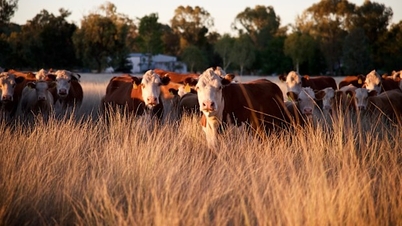Hoa An Commune, one of the localities most severely affected by the floods, these days, everywhere you can see people busily restoring production. In the fields of Na Me hamlet, Thai Cuong, traces of the flood are still evident. Thick mud, broken corn stalks, and scattered vegetables. Among the waterlogged land, a few new green shoots have sprouted, which is proof of the strong vitality of the people here, no matter how severe the natural disaster is, they still refuse to give up.
In the middle of the rice field that had just dried after the storm and flood, Ms. Hoang Thi Binh, a resident of Na Me hamlet, was diligently harvesting each remaining rice flower. Ms. Binh shared: During the flood days, looking at the flooded rice fields made my heart feel like it was on fire. My family has more than 3,000 square meters, the rice and corn are almost all damaged, as the water receded, my family and I checked and harvested the remaining areas. It was a pity to leave the land empty, after harvesting all this rice, I leveled the field and planted vegetables in time for the winter crop.
Not far away, Mr. Duong Van Khoan and his son are plowing the flooded land. His family has more than 7,000 square meters of vegetables, mainly cabbage, pickled mustard greens and squash. The recent flood caused the entire area to be flooded, causing damage of more than 100 million VND. Mr. Khoan said: The family is planning to convert part of the area to grow short-term vegetables such as mustard greens, onions and garlic to sell at the end of the year.

In Thai Cuong hamlet, Hoa An commune, the consequences of the flood are still evident. The hamlet has more than 120 households, of which 74 had their houses flooded. Ms. Nguyen Thi Han, who has nearly 3,000 square meters of agricultural land, shared: When the water rose, the corn was left with only the roots, and all the vegetables were crushed. I lost the whole crop. But with the support of seeds and rice from the commune and several charity groups, and agricultural officers coming down to guide me on how to treat the land, I was confident. People now intercrop all kinds of crops, in dry areas they plant carrots, in moist areas they plant water spinach and mustard greens. Starting over, but seeing the sprouts sprouting makes me feel secure, and I expect to still have vegetables to sell this Tet.
It can be seen that the fields in Na Me and Thai Cuong are still covered with mud, but interspersed with rows of young vegetables and rows of newly plowed potatoes. According to statistics from the People's Committee of Hoa An commune, the recent flood caused damage to 349 hectares of crops. Of which, 159.4 hectares of corn, 148.7 hectares of rice, 31.6 hectares of vegetables, 9.4 hectares of fruit trees, and 2.9 hectares of fish ponds were severely affected. In addition, dozens of irrigation works, canal banks, and ditch banks were eroded and filled. Vice Chairman of the People's Committee of Hoa An commune, Chu Phuong Thanh, said: After only a few days of water receding, the commune mobilized all militia, mass organizations, and youth unions to go to the fields with the people to clear mud and clear ditches. The commune determined to restore production as soon as possible, because if it was delayed for a few days, the winter crop would be missed. At the same time, we reviewed and made a list of emergency support for seeds, fertilizers, and technical guidance on post-flood soil treatment. In addition, we also called on organizations and individuals to support the people. The biggest difficulty was that the canal system was filled up, so we had to both clear it and temporarily divert water. But the people's spirit was very good, no one sat and waited. They repaired, cleaned, and helped each other. Some hamlets replanted after only 5 days.
According to statistics from the Department of Agriculture and Environment, the total area of crops damaged by floods in the province is up to 7,356 hectares; of which 4,352 hectares are rice, 2,701 hectares are annual crops, and 303 hectares are perennial crops. In addition, 27 hectares of production land were completely eroded. The damage to livestock, agricultural infrastructure, and housing was also very large, affecting the livelihoods of tens of thousands of rural households. Sharing about the recovery work, Mr. Nguyen Cong Doanh, Deputy Director of the Department of Agriculture and Environment, said: Immediately after the flood, the Department deployed many measures simultaneously. First of all, it was necessary to accurately assess the damage, not to miss any affected subjects. Then, it provided technical guidance on soil treatment, selected short-term varieties, and supported people to restore winter crop production. It directed veterinary and agricultural extension stations to go to the site to coordinate disinfection spraying and vaccination to prevent disease outbreaks after flooding. In addition, the agricultural sector has coordinated with seed centers and local businesses to quickly supply rice, corn, and vegetable seeds. At the same time, mobilized forces to temporarily repair eroded canals, ensuring irrigation water for key production areas. As of early November, the whole province has supported people to overcome damage to houses, crops, and livestock with a total cost of more than 50 billion VND. However, it is currently still reviewing and reporting to superiors to allocate capital to continue supporting people to restore production. With the guiding spirit of not leaving any household behind. Along with State resources, the Department is calling on organizations and businesses to continue supporting materials, seeds, and animals, so that people can restore their fields as soon as possible.
In the fields that have just been flooded in the communes of Hoa An, Quang Uyen, Nguyen Binh… the sound of tractors resounds loudly again. Taking advantage of the sunny days, people are urgently planting the winter crop. Although the road to recovery is still long, the fields in the province are reviving day by day. In the fields, rows of young vegetables have turned green again. The mud will dry, but the sprouts of life continue to grow, which proves the strong vitality, faith and aspiration to overcome of the people in the mountainous areas.
Source: https://baocaobang.vn/no-luc-khoi-phuc-san-xuat-nong-nghiep-sau-thien-tai-3182599.html





































































































Comment (0)